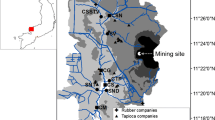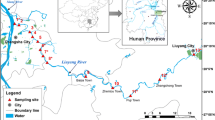Abstract
The aim of this work was to statistically evaluate the presence of various contaminants in fish in the copper mining-impacted Morphou Bay. Multivariate data techniques were used to analyse the contamination in seasonally encountered fish. Principal component analysis was used to classify the contaminants with respect to factor loadings. Red mullet, a local deep feeder, was found to be affected at 66% of factor loadings in variance, with a linear correlation between arsenic (As) and copper (Cu). Agglomerative hierarchical clustering linked three similar clusters: (As, Cu, Se, Zn), (Cd, Cr, Hg), and (Ni, Pb) and we merged them in a dendrogram. The self-organising maps were developed by combining the artificial neural network analysis classified data with the sub-patterns, while considering the results of principal component and clustering analysis. The resultant maps effectively distinguished the correlations between the contaminants in the sampled fish. Based on the results, we suggest that human consumption of fish from the polluted area should only take place with caution and that the study be repeated using a more elaborate sampling strategy.
Zusammenfassung
Das Ziel dieser Arbeit war es, das Vorhandensein verschiedener Schad-stoffe in Fischen in der vom Kupferabbau beeinflussten Morphou Bucht statistisch zu untersuchen. Multivariate Datenverfahren wurden verwendet, um die Belastung in saisonal angetroffenen Fischen zu analysieren. Die Hauptkomponentenanalyse wurde genutzt, um die Schadstoffe in Bezug auf die Faktorladungen zu klassifizieren. Mit einer Faktorladung, die 66 % der Varianz erklärt, zeigte sich für Rotbarben eine lineare Korrelation zwischen Arsen (As) und Kupfer (Cu). Mit der agglo-merativen hierarchischen Clusteranalyse wurden drei Cluster: (As, Cu, Se, Zn), (Cd, Cr, Hg) und (Ni, Pb) differenziert und in einem Dendrogramm dargestellt. Durch Kombination der klassifizierten Daten aus der künstlichen neuronalen Netzwerkanalyse mit den Untergruppen wurden Kohonennetze erstellt. Dabei wurden die Ergebnisse der Hauptkomponenten- und Clusteranalyse berücksichtigt. Die so erzeugten Karten zeigten eine deutliche Korrelation zwischen den Schadstoffen in den beprobten Fischen. Basierend auf den Ergebnissen, empfehlen wir den Verzehr von Fischen aus belasteten Gebieten nur unter Vorsicht. Außerdem sollte die Studie mit einer verbesserten Probenahme¬strategie wiederholt werden.
Resumen
El objetivo de este trabajo fue evaluar estadísticamente la presencia de diversos contaminantes en peces en la bahía de Morphou, afectada por la extracción de cobre. Se usaron técnicas de datos multivariantes para analizar la contaminación en peces de temporada. El análisis del componente principal se utilizó para clasificar los contaminantes con respecto a los factores de carga. El salmonete, un comedero profundo local, se encontró afectado al 66% de las cargas de factores en varianza, con una correlación lineal entre el arsénico (As) y el cobre (Cu). La clusterización jerárquica aglomerativa vincula tres clusters similares: (As, Cu, Se, Zn), (Cd, Cr, Hg) y (Ni, Pb) y fueron fusionados en un dendrograma. Los mapas autoorganizados se desarrollaron combinando los datos clasificados del análisis de red neuronal artificial con los subpatrones, mientras se consideraban los resultados del análisis del componente principal y del análisis por clusters. Los mapas resultantes distinguieron efectivamente las correlaciones entre los contaminantes en los peces muestreados. En base a los resultados, sugerimos que el consumo humano de pescado del área contaminada sólo debe tener lugar con precaución y que el estudio debe repetirse utilizando una estrategia de muestreo más elaborada.
抽象
文章旨在统计评价受铜矿开采影响的Morphou海湾鱼体内各类污染物。多变量分析方法用以分析季节性鱼体内污染。采用主成分分析进行污染物因子载荷分类。红鲻鱼是一种地方性深水鱼,公共因子方差的因子载荷贡献率达66%,砷(As)与铜(Cu)呈线性关系。层次聚类分析将污染物为三个集群(As, Cu, Se, Zn)、(Cd, Cr, Hg)和 (Ni, Pb),并绘制于一张树形图。考虑主成分分析和聚类分析结果,通过人工神经网络建立了自组织图。自组织图能够有效地区分样本鱼体内污染物。基于研究结果,建议人类小心食用污染区鱼类,建议采用更精细取样方案进行重复试验。






Similar content being viewed by others
References
Altinbas U, Erdem U, Veryeri NO (2001) Effects of CMC mining on natural resources in Lefke. In: Proceedings, international conference on European environmental policy and the case of Cyprus Mines, Lefke, pp 9–27
Asadi R, Asadi M, Kareem SA (2016) An efficient semisupervised feedforward neural network clustering. Artif Intell Eng Des Anal Manuf 30(1):1–15. https://doi.org/10.1017/S0890060414000675
Atimtay A, Saricicek EV (2001) Environmental effects of the copper mining activities in Lefke-Gemikonağı region of Cyprus: a review. In: Proceedings, international European union environmental policy and the case of Cyprus Mines, European University of Lefke, pp 1–8
Baycu G, Tolunay D, Ozden H, Csatari I, Karadag S, Aqba T, Rognes SE (2015) An abandoned copper mining site in Cyprus and assessment of metal concentrations in plants and soil. Int J Phytoremediat 17(7):622–631. https://doi.org/10.1080/15226514.2014.922929
Cetinkaya G, Sozen N (2011) Plant species potentially useful in the phytostabilization process for the abandoned CMC mining site in northern Cyprus. Int J Phytoremediat 13(7):681–691. https://doi.org/10.1080/15226514.2010.500155
Charou E, Stefouli M, Dimitrakopoulos D, Vasiliou E, Mavrantza OD (2010) Using remote sensing to assess impact of mining activities on land and water resources. Mine Water Environ 29(1):45–52. https://doi.org/10.1007/s10230-010-0098-0
Chu H, Lu W, Zhang L (2013) Application of artificial neural network in environmental water quality assessment. J Agric Sci Technol 15(2):343–356
Cyprus (1931–1938a) Cyprus blue book. Print Office, National Archives, Kyrenia
Cyprus (1935–1938b) Cyprus gazette. Print Office, National Archives, Kyrenia
Denis-Karafistan A (1998) Application of principal component analysis to radio properties of quasars. Astron Nachr 319(5):319–324. https://doi.org/10.1002/asna.2123190507
Di Salvo F, Ruggieri M, Plaia A (2015) Functional principal component analysis for multivariate multi-dimensional environmental data. Environ Ecol Stat 22(4):739–757. https://doi.org/10.1007/s10651-015-0317-8
Duruibe JO, Ogwuegbu MOC, Egwurugwu JN (2007) Heavy metal pollution and human biotoxic effects. Int J Phys Sci 2(5):112–118
EMEA (European Medicines Agency) (2002) Evaluation of medicines for human use (CPMP/SWP/QWP/4446/00). The European Agency for the Evaluation of Medicinal Products, pp 1–23
Gucel S, Ozturk M, Yucel E, Kadis C, Guvensen A (2009) Studies on trace metals in soils and plants growing in the vicinity of copper mining area-Lefke, Cyprus. Fresen Environ Bull 18(3):360–368
Helbich M, Hagenauer J (2017) Data on healthy food accessibility in Amsterdam, the Netherlands. Data 2(1):7. https://doi.org/10.3390/data2010007
Hellberg RS, DeWitt CAM, Morrissey MT (2012) Risk-benefit analysis of sea food consumption: a review. Compr Rev Food Sci Food Saf 11(5):490–517. https://doi.org/10.1111/j.15414337.2012.00200.x
Hubert L, Kohn H-F, Steinley D (2009) Cluster analysis: a toolbox for Mat Lab. The SAGE handbook of quantitative methods in psychology. SAGE, London. https://doi.org/10.4135/9780857020994.n20
Idris AM, Said TO, Omran AA, Fawy KF (2015) Combining multivariate analysis and human risk indices for assessing heavy metal contents in muscle tissues of commercially fish from southern Red Sea, Saudi Arabia. Environ Sci Pollut Res 22(21):17012–11721. https://doi.org/10.1007/s11356-015-4921-9
Johansson L, Xydas C, Messios N, Stoltz E, Greger M (2005) Growth and Cu accumulation by plants grown on Cu containing mine tailings in Cyprus. Appl Geochem 20(1):101–107. https://doi.org/10.1016/j.apgeochem.2004.07.003
Kohonen T (2013) Essentials of the self-organizing map. Neural Netw 37:52–65. https://doi.org/10.1016/j.neunet.2012.09.018
Piepponen S, Lindstrom R (1989) Data analysis of heavy metal pollution in the sea by using principal component analysis and partial least squares regression. Chemom Intell Lab 7:163–170. https://doi.org/10.1016/0169-7439(89)80120-0
Ribeiro L, Kretschmer N, Nascimento J, Buxo A, Rötting TS, Soto G, Soto M, Oyarzu´n J, Maturana H, Oyarzu´n R (2014) Water quality assessment of the mining-impacted Elqui River basin, Chile. Mine Water Environ 33(2):165–176. https://doi.org/10.1007/s10230-014-0276-6
Tsai WP, Huang SP, Cheng ST, Shao KT, Chang FJ (2017) A data-mining framework for exploring the multi-relation between fish species and water quality through self-organizing map. Sci Total Environ 579:474–483. https://doi.org/10.1016/j.scitotenv.2016.11.071
Yukselen M (2002) Characterization of heavy metal contaminated soils in northern Cyprus. Environ Geol 42(6):597–603. https://doi.org/10.1007/s00254-002-0556-5
Acknowledgements
The data was collected by one of us (A.K.) within the scope of a Near East University Research Project (YDU/2009-08). We also acknowledge support from the Turkish Technological and Research Council (TUBITAK-YDABAG) for the various analyses (Dr. Deniz Sarica, chemist). We also thank Dr. S. Hutchinson Blue for linguistic corrections.
Author information
Authors and Affiliations
Corresponding author
Additional information
Dedicated to our ancestors.
Rights and permissions
About this article
Cite this article
Karafistan, A., Gemikonakli, E. Contaminant Evaluation in Fish from the Mining-Impacted Morphou Bay, Cyprus, Using Statistical and Artificial Neural Network Analysis. Mine Water Environ 38, 178–186 (2019). https://doi.org/10.1007/s10230-018-0559-4
Received:
Accepted:
Published:
Issue Date:
DOI: https://doi.org/10.1007/s10230-018-0559-4




